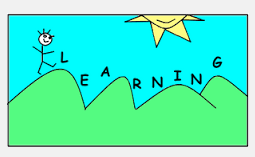 |
| A super guide for teaching math well! |
To answer my own question, I will create Boaler's "floor to ceiling" learning experiences that have what I've always called the 1-2-3 approach where 1 is review, 2 is grade level, and 3 is enrichment. I always open all levels to all students. Willingham in his book, Why Don't Students Like School, affirms the opportunity that exists when students review material that they "know" since there's always more depth to be gained by that review. I know that to be true because I've taught similar standards for years and each time I teach the standards anew I make more connections and learn more.
So with this 1-2-3 or "floor-to-ceiling" approach what's important and how does it work?
It works like this. Students enter the experience at level 1 with a review. For some the review will be quick and pointed, and for others the review stage will represent new learning. Level two is the grade-level norm or standard, and the place that we hope most students will master with the support of educators, classmates, and family members. The third level is enrichment and it's open to all. I find that when I open the enrichment level to all, it's amazing to see who reaches since it's never just those students you'd expect to reach. Often a child who struggles in one area of math may reach in another. That's why I'm not a fan of permanent grouping especially in the early years. I like the flexible grouping we use during RTI related to specific skills, knowledge, and concept goals.
 |
| Another great book when it comes to matching learning with how the brain works. |
- Introduce everyone to the big idea in an intriguing way.
- Scaffold the experience so there are levels 1-2-3 and all levels are open to all.
- Leave the experience "loose-tight" with plenty of room for student choice and voice.
- Make time and space for discussion, share, and response.
- Use teamwork when possible and be strategic about how you create groups. Use a variety of group types so that students are working with like-partners, unlike-partners, mixed-ability groups, like-ability groups, interest-based groups, and more. As you employ various types of grouping, observe which groups inspire, engage, motivate, and forward student learning.
- Use strengths/interest-based content and approaches as much as possibly and introduce many ways to learn and let students try out all the various ways to learn too.
We can't predict how a child one or more years away from the curriculum grade-level standards will learn and grow. Sometimes when a learning experience is truly engaging, a child will leap ahead and demonstrate significant growth. Sometimes students will do this even if the experience isn't engaging as they reach a point of cognitive shift that helps them to merge and consolidate ideas with greater ease and strength.
There are also times when a student remains stuck with a concept, knowledge, or skill. Give it the good try in multiple ways, and then take a break and return to that learning point later.
 |
| Learning is not linear. |
How do you teach students who are behind when it comes to standards learning? Please share as I want to broaden my understanding of this as much as possible as I now we can grow our expertise in this area.